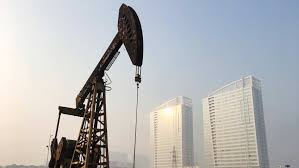The oil price swings dramatically

THE OIL price was supposed to be soaring around now. With American sanctions against Iran taking effect earlier this month, exports from that country, the world’s fourth-largest producer of crude oil last year, were expected to shrink to close to zero. In anticipation the price of Brent crude, the international benchmark, went above $ 86 in early October, a four-year-high, and some warned of prices above $ 100 a barrel.
Instead, by November 8th oil had entered a bear market. The price of Brent crude stood at $ 66.53 on November 14th. West Texas Intermediate, the American oil benchmark, dropped for 12 straight trading sessions, until November 14th, when it at last ticked up (see chart). That was the longest uninterrupted decline in over three decades. American crude futures have plunged by 20% from their recent peak.
Some of the reasons for the slump are standard fare. In October the IMF lowered its forecast for global economic growth. Trouble in emerging markets has an outsize effect on their demand for dollar-denominated oil, as it becomes more expensive in weakening local currencies. But the oil market’s recent volatility also reflects new forces, including the limits of conventional producers and the peculiar impact of America’s president, Donald Trump.
The Organisation of Petroleum Exporting Countries (OPEC), led by Saudi Arabia, aspires to cosy stability. Prices should be high enough to sustain its members’ budgets and low enough to support global demand. But its grip has slipped. There are now three dominant oil producers: America, Saudi Arabia and Russia, only one of which is a member. As America’s shale industry has boomed, Saudi Arabia has turned to Russia to help co-ordinate production. Their interests are not perfectly aligned. Saudi Arabia’s oil minister, Khalid al-Falih, this week said the kingdom would lower output by 500,000 barrels a day in December; Russia’s oil minister doubted that there would be oversupply.
But it is America that has had the greatest destabilising effect. This year it became the world’s top producer of crude. Its shale companies are pumping out oil at a phenomenal rate. Output in August was 23% above the level 12 months earlier. But the shale industry is beholden to investors, not an oil minister, and production may taper if oil prices continue to slide and investors demand higher returns. On top of that come Mr Trump’s policies, which are helping to shove oil markets this way and that.
After he announced sanctions on Iran in May, OPEC and its allies agreed to increase output. Production from Saudi Arabia and Russia has climbed to record highs. Then, on November 5th, America announced that it would grant 180-day waivers to China, India and six other countries to continue to import from Iran—countries that together account for more than 75% of Iranian exports, according to Sanford C. Bernstein, a research firm.
Mr Trump’s trade policies are also depressing demand for oil. The IMF’s lower forecast for growth is due in part to a slowdown in emerging markets, but also to rising tensions between America and its trading partners, a strain that further weakens emerging economies. The growth in air freight and shipping has fallen by about half in the past year, says Edward Morse of Citigroup, depressing demand for diesel fuel. Mr Trump’s trade war with China is particularly important for oil markets, as China accounted for about 40% of the growth in demand for oil last year. On November 13th OPEC lowered its forecast for global oil demand next year.
But even as oil prices fall, there is reason to think they could spike again soon. More production cuts may come next month, after OPEC and its partners meet in Vienna. On top of uncertainty in Iran, disruption in Venezuela, Libya, Nigeria or Iraq could squeeze global supply. These “fragile five”, as some investors call them, accounted for 12% of global oil production from July to September, more than Saudi Arabia.
Then there is always the possibility that Mr Trump could reverse course—striking a trade deal with China, for instance, or tightening restrictions on Iran once more. Or he might simply write a tweet. On November 12th he took to Twitter to call on OPEC to refrain from cutting production. The oil price fell.
This article appeared in the Finance and economics section of the print edition under the headline “Trumpsy turvy”